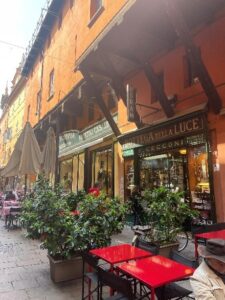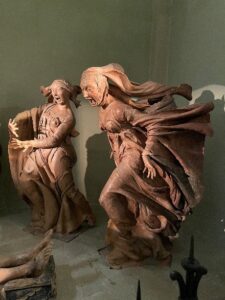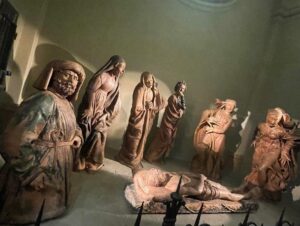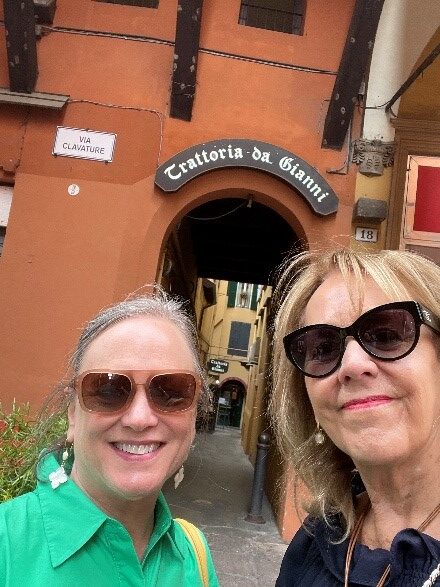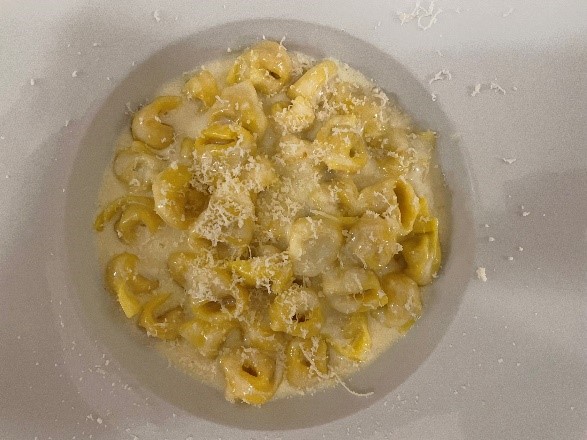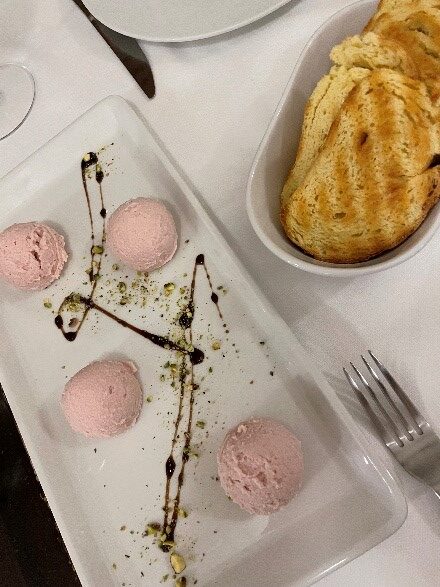Submitted by Carol Faenzi
A quick 30-minute train ride from Florence and you can be in Bologna! Exit Tuscany, enter Emilia Romagna.
Bologna was a city I had never visited before on my many trips to Italy, although my great great grandmother, Cesira Bettuchi was born there.
The region of Emilia Romagna is the area of Italy known mostly for its reputation of being the best place for gastronomical of experiences, which is saying something considering how many great food experiences can be had in our mother country. Bologna is not called la Grassa (The Fat) for any other reason.
Lasagna Bolognese, Tortellini, Mortadella, Parmigiano Reggiano, Balsamico, and Prosciutto di Parma, are just a few of the exquisite ingredients and dishes that were born and perfected in this rich agricultural region.
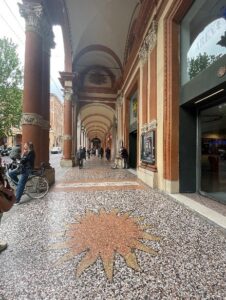 Bologna is its capital and in May, I took the Freccia Rossa (Red Arrow) train with my friend, Leslie to explore the city and of course, have lunch.
Bologna is its capital and in May, I took the Freccia Rossa (Red Arrow) train with my friend, Leslie to explore the city and of course, have lunch.
Once disembarking, you are a very short walk into the historic center. The first thing one notices is the vast network of porticoes that are not only an architectural gem but give shelter from the elements. Protected as a World Heritage Site, the porticoes cover a distance of some 38 miles! They were built starting in the 12th century and have continued to evolve architecturally over the centuries.
There are several important things to know about and see in Bologna.
In addition to being referred to as la Grassa (the Fat), it is also known as la Rossa (the Red) and la Dotta (The Learned).
Rossa is for both its red tile roofs and its Leftist Politics. Dotta because Bologna’s university is the oldest continually operating university in the world, founded in 1088. Dante, Boccaccio and Petrarch, the literary fathers of Italy, all were students. Several foreign universities, including Indiana University, have campuses in Bologna.
The student population in Bologna certainly gives it a vibrant energy that I could feel as we walked around. Perhaps also due to its liberal politics, there was an openness, friendliness, that felt welcoming.
 Did you know that Bologna is also known as la Turrita (The Towered) due to the many medieval towers within the city? It is estimated that during Medieval times, the city contained 100, some of them mentioned by Dante in his famous Inferno of the Divine Comedy.
Did you know that Bologna is also known as la Turrita (The Towered) due to the many medieval towers within the city? It is estimated that during Medieval times, the city contained 100, some of them mentioned by Dante in his famous Inferno of the Divine Comedy.
The most famous of the remaining are Asinelli and the one that leans, Garisenda.
“As when one sees the tower
Called Garisenda
from underneath its leaning side,
and then a cloud passes over
and it seems to lean the more….”
Divine Comedy, Inferno
Canto XXXI, 136
The most famous work of art in the city is The Lamentation Over the Dead Christ, Il Compianto del Cristo Moro, a group of terracotta sculptures by sculptor Niccolò dell’Arca. This masterpiece is located in the Sanctuary of Santa Maria della Vita. This is a must see.
The artist was not well known to me. From Bari in Puglia, he worked during the years of the Early Renaissance period (mid-1460s), heavily influenced by Donatello.
The sculptures are life-sized. It is a powerful and emotional depiction, each person displaying the different facets of grief. All the faces and the hands drew me in and told the story.
The four Marys: Mary of Cleophas at his feet seems to be screaming and leaning in against a violent wind. Mary Magdalene has her hands in front of her and her clothing moves with her emotion. Mary the mother of James and John has her hands on her thighs. The Madonna’s hands are clenched in resignation as she knew this day would come.
In the center is Saint John holding his chin with his palm, contemplating his disbelief, composed but obviously in deep pain.
Who is the man on the left, looking at us? His clothing is Renaissance, a modern looking man during the time of the work. He is not showing his emotions. He is Joseph of Arimathea but it is thought he is the patron of the art, the man who commissioned the sculpture.
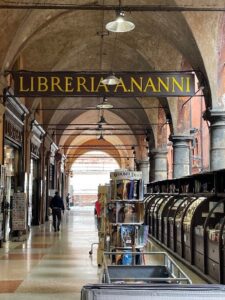 We wanted to visit the oldest bookstore in the City, Libreria Nanni. Located under Il Portico della Morte (Portico of Death), it is a treasure trove of rare ancient books, texts for students, magazines, virtually anything literary. It’s a good thing there is someone there to help you because this is not a store you can find your own way through easily. It is akin to archaeology. You know you are entering a portal into all of history.
We wanted to visit the oldest bookstore in the City, Libreria Nanni. Located under Il Portico della Morte (Portico of Death), it is a treasure trove of rare ancient books, texts for students, magazines, virtually anything literary. It’s a good thing there is someone there to help you because this is not a store you can find your own way through easily. It is akin to archaeology. You know you are entering a portal into all of history.
It was time for lunch. We had abandoned the idea of trying to find online the best place in Bologna to eat lasagna or tortellini. We decided to let a restaurant find us and we stumbled upon Trattoria da Gianni tucked in one of the many charming vicoli (narrow streets) in the city center.
It did not disappoint.
We ordered the house speciality, Spuma di Mortadella (Mortadella Mousse). It arrived looking like scoops of pink gelato. Mortadella, when made authentically, is sliced and has a texture like silk, stuffed with pistachios and so o delicate. When it’s made into a mousse, it is taken to another level.
Leslie managed to order the very last piece of lasagna verde (the pasta is made with spinach) available that day and she declared it the best dish she had eaten in Italy. My tortellini in melted pecorino cheese tasted like a memory at my grandmother’s table.
Lorem ipsum dolor sit amet, consectetur adipiscing elit. Ut elit tellus, luctus nec ullamcorper mattis, pulvinar dapibus leo.

